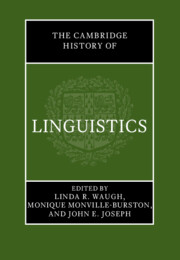Book contents
- The Cambridge History of Linguistics
- The Cambridge History of Linguistics
- Copyright page
- Dedication
- Contents
- Figures
- Tables
- Contributors
- Preface
- Acknowledgments
- Abbreviations, Acronyms, Special Symbols, and Other Conventions
- Introduction
- Part I Ancient, Classical, and Medieval Periods
- Part II Renaissance to Late Nineteenth Century
- Introduction to Part II The Cultural and Political Context of Language Studies from the Renaissance to the End of the Nineteenth Century
- 7 Universal Language Schemes
- 8 Locke and Reactions to Locke, 1700–1780
- 9 Rousseau to Kant
- 10 The Celebration of Linguistic Diversity: Humboldt’s Anthropological Linguistics
- 11 Early Nineteenth-Century Linguistics
- 12 The Neogrammarians and their Role in the Establishment of the Science of Linguistics
- Part III Late Nineteenth-through Twentieth-Century Linguistics
- Part IIIA Late Nineteenth Century through the 1950s: Synchrony, Autonomy, and Structuralism
- Part IIIB 1960–2000: Formalism, Cognitivism, Language Use and Function, Interdisciplinarity
- References
- Index
7 - Universal Language Schemes
from Part II - Renaissance to Late Nineteenth Century
Published online by Cambridge University Press: 20 July 2023
- The Cambridge History of Linguistics
- The Cambridge History of Linguistics
- Copyright page
- Dedication
- Contents
- Figures
- Tables
- Contributors
- Preface
- Acknowledgments
- Abbreviations, Acronyms, Special Symbols, and Other Conventions
- Introduction
- Part I Ancient, Classical, and Medieval Periods
- Part II Renaissance to Late Nineteenth Century
- Introduction to Part II The Cultural and Political Context of Language Studies from the Renaissance to the End of the Nineteenth Century
- 7 Universal Language Schemes
- 8 Locke and Reactions to Locke, 1700–1780
- 9 Rousseau to Kant
- 10 The Celebration of Linguistic Diversity: Humboldt’s Anthropological Linguistics
- 11 Early Nineteenth-Century Linguistics
- 12 The Neogrammarians and their Role in the Establishment of the Science of Linguistics
- Part III Late Nineteenth-through Twentieth-Century Linguistics
- Part IIIA Late Nineteenth Century through the 1950s: Synchrony, Autonomy, and Structuralism
- Part IIIB 1960–2000: Formalism, Cognitivism, Language Use and Function, Interdisciplinarity
- References
- Index
Summary
The co-authors of this chapter discuss universal languages created from the seventeenth to the nineteenth century. Broadly defined, universal language schemes are artificially constructed languages used as auxiliary codes to facilitate communication, but they vary in the motivations for their creation and internal design. Usually, they are constructed to overcome language barriers, improve upon the irregularities of natural languages, and aim at easy learnability. Concerning their internal aspects, three types are distinguished: ‘universal characters’ (no use of sounds); simplified forms of existing languages; newly constructed languages (‘a priori ‘or ‘a posteriori’). With the decline of Latin, in the seventeenth century universal languages were popular and widely discussed in intellectual circles. They were ‘universal characters,' ‘real characters’ (the created words represented properties of things), ‘philosophical’ (Dalgarno, Wilkins) or aimed at guiding logical thinking (Leibniz). In late eighteenth century, philosophers/ideologues took interest in universal languages and ‘pasigraphies’ were invented. In thenineteenth century, universal languages developed in two directions: formal languages constructed by logicians, differing in structure from natural languages (Frege); international auxiliary languages — Volapuk, Esperanto — which, due to increasing internationalism, were successful. The idea of creating a universal language was supported by some prominent linguists.
Keywords
- Type
- Chapter
- Information
- The Cambridge History of Linguistics , pp. 233 - 257Publisher: Cambridge University PressPrint publication year: 2023



